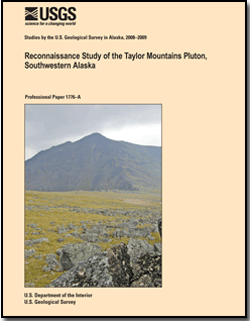U.S. Geological Survey Professional Paper 1776–D
ABSTRACT
This report is a new compilation of the location and extent of folds and faults in Cook Inlet Basin, Alaska. Data sources are previously published maps, well locations, and seismic-reflection data. We also utilize interpretation of new aeromagnetic data and some proprietary seismic-reflection data. Some structures are remarkably well displayed on frequency-filtered aeromagnetic maps, which are a useful tool for constraining the length of some structures. Most anticlines in and around the basin have at least shows of oil or gas, and some structures are considered to be seismically active. The new map better displays the pattern of faulting and folding. Deformation is greatest in upper Cook Inlet, where structures are oriented slightly counterclockwise of the basin bounding faults. The north ends of these structures bend to the northeast, which gives a pattern consistent with right-transpressional deformation. Subduction of the buoyant Yakutat microplate likely caused deformation to be focused preferentially in upper Cook Inlet. The upper Cook Inlet region has both the highest degree of shortening and the deepest part of the Neogene basin. This forearc region has a long-wavelength magnetic high, a large isostatic gravity low, high conductivity in the lower mantle, low p-wave velocity (Vp), and a high p-wave to shear-wave velocity ratio (Vp/Vs). These data suggest that fluids in the mantle wedge caused serpentinization of mafic rocks, which may, at least in part, contribute to the long-wavelength magnetic anomaly. This area lies adjacent to the subducting and buoyant Yakutat microplate slab. We suggest the buoyant Yakutat slab acts much like a squeegee to focus mantle-wedge fluid flow at the margins of the buoyant slab. Such lateral flow is consistent with observed shear-wave splitting directions. The additional fluid in the adjacent mantle wedge reduces the wedge viscosity and allows greater corner flow. This results in focused subsidence, deformation, and gravity anomalies in the forearc region. |
TextData
For additional information contact: Part of this report is presented in Portable Document Format (PDF); the latest version of Adobe Reader or similar software is required to view it. Download the latest version of Adobe Reader, free of charge. |
Haeussler, P.J., and Saltus, R.W., 2011, Location and extent of Tertiary structures in Cook Inlet Basin, Alaska, and mantle dynamics that focus deformation and subsidence, in Dumoulin, J.A., and Galloway, J.P., eds., Studies by the U.S. Geological Survey in Alaska 2008–2009: U.S. Geological Survey Professional Paper 1776–D, 26 p.
Abstract
Introduction
Geologic Overview
Data Sources
Tertiary Structures in Cook Inlet
Discussion
Concluding Remarks
Acknowledgments
References
database